Calvary
Calvary, or Golgotha (Koinē Greek: Γολγοθᾶ[ς] Golgothâ[s], traditionally interpreted as reflecting Syriac: ܓܘܠܓܘܠܐ golgolṯā,[1][2] as it were Hebrew gulgōleṯ "skull" (גולגולת),[3][4] Arabic: جلجثة), was, according to the canonical Gospels, a site immediately outside Jerusalem's walls where Jesus was crucified.[5]
.jpg)
The canonical Gospels use the Koine term Kraníon (Κρανίον)[6] when testifying to the place outside Jerusalem where Jesus was crucified. Kraníon is often translated as "Skull" in English, but more accurately means Cranium, the part of the skull enclosing the brain. In Latin it is rendered Calvariae Locus, from which the English term Calvary derives.
Its traditional site, identified by Queen Mother Helena, mother of Constantine the Great, in 325, is at the site of the Church of the Holy Sepulchre. A 19th-century suggestion places it at the site now known as The Garden Tomb on Skull Hill, some 500 m (1,600 ft) to the north, and 200 m (660 ft) north of the Damascus Gate. Historian Joan E. Taylor bases a location c. 175 m (574 ft) south-southeast of the traditional site on her reading of textual evidence.[7]
Biblical references and etymology
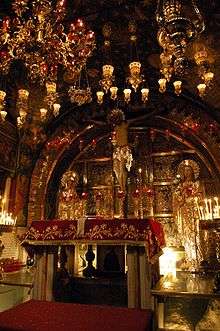
The recorded form Γολγοθα may be a simplified pronunciation of an Aramaic golgolta,[8] corresponding to Hebrew gulgōleṯ (גֻּלְגֹּלֶת) "skull".[3]
English Calvary is the anglicized form of the Latin gloss from the Vulgate (Calvariæ), to refer to Golgotha in Luke 23:33, where the Greek text gives Κρανίον rather than the explicit Κρανίου Τόπος of Matthew 27:33, Mark 15:22 and John 19:17. The adoption of the Latin form has a long tradition in English Bible translations, going back to at least the late 10th century (Wessex Gospels[9]), and is retained in Wycliffe's Bible and Tyndale's Bible as well as in the King James Version. By contrast, Martin Luther translates Luke's Κρανίον into German as Schädelstätte ("place of skull(s)").[10] The Latinism is also current in various other languages within the Latin sphere of influence, including Spanish and Italian Calvario, French Calvaire, Polish Kalwaria, Lithuanian Kalvarijos.
The church fathers offer different interpretations for the name; either deriving it from a topographic feature resembling a cranium (Pseudo-Tertullian),[11] or alternatively as the site where the skull of Adam was said to be buried (Origenes), or from the skulls of those executed there (Jerome, locum decollatorum).[12]
The association of the site with the "skull of Adam" is expanded in a number of noncanonical Christian writings, including the Kitab al-Magall, the Conflict of Adam and Eve with Satan, the Cave of Treasures, as well as by Patriarch Eutychius of Alexandria (9th century). According to these accounts, Shem and Melchizedek traveled to the resting place of Noah's Ark, retrieved the body of Adam from it, and were led by Angels to Golgotha – described as a skull-shaped hill at the centre of the Earth, where also the serpent's head had been crushed following the Fall of Man.[12]
While the Gospels merely identify Calvary as a "place" (τόπος), Christian tradition since at least the 6th century has described the location as a "mountain" or "hill".[12]
The location itself is mentioned in all four canonical Gospels:
- Matthew 27:33: "And when they were come unto a place called Golgotha [Γολγοθᾶ], that is to say, a place of a skull [Κρανίου Τόπος]" (KJV)
- Mark 15:22: "And they bring him unto the place Golgotha [Γολγοθᾶ], which is, being interpreted, The place of a skull [Κρανίου Τόπος]" (KJV)
- Luke 23:33: "And when they were come to the place, which is called Calvary [Κρανίον], there they crucified him, and the malefactors, one on the right hand, and the other on the left." (KJV)
- John 19:17: "And he bearing his cross went forth into a place called the place of a skull [Κρανίου Τόπον], which is called in the Hebrew Golgotha [Γολγοθα]." (KJV)
An alternative suggestion, due to Krafft (1846)[13] proposes that the reported association with the word "skull" is a popular etymology of an original name Gol Goatha, interpreted (by Krafft) as meaning "heap of death", or "hill of execution"; the supposed toponym Goatha has also been identified, by Ferguson (1847), with the location called Goʿah (גֹּעָה)[14] in Jeremiah 31:39, in a description of the geography of Jerusalem.[15]
Location
There is no consensus as to the location of the site. John (19:20) describes the crucifixion site as being "near the city". According to Hebrews (Hebrews 13:12), it was "outside the city gate". Matthew 27:39 and Mark 15:29 both note that the location would have been accessible to "passers-by". Thus, locating the crucifixion site involves identifying a site that, in the city of Jerusalem some four decades before its destruction in AD 70, would have been outside a major gate near enough to the city that the passers-by could not only see him, but also read the inscription 'Jesus the Nazarene, the King of the Jews'.[16]
Church of the Holy Sepulchre
Christian tradition since the fourth century has favoured a location now within the Church of the Holy Sepulchre. This places it well within today's walls of Jerusalem, which surround the Old City and were rebuilt in the 16th century by the Ottoman Empire. Proponents of the traditional Holy Sepulchre location point out at the fact that first-century Jerusalem had a different shape and size from the 16th-century city, leaving the church's site outside the pre-AD 70 city walls. Those opposing it doubt this.
Defenders of the traditional site have argued that the site of the Church of the Holy Sepulchre was only brought within the city limits by Herod Agrippa (41–44), who built the so-called Third Wall around a newly-settled northern district, while at the time of Jesus' crucifixion around AD 30 it would still have been just outside the city.
Henry Chadwick (2003) argued that when Hadrian's builders replanned the old city, they "incidentally confirm[ed] the bringing of Golgotha inside a new town wall."[17]
In 2007 Dan Bahat, the former City Archaeologist of Jerusalem and Professor of Land of Israel Studies at Bar-Ilan University, stated that "Six graves from the first century were found on the area of the Church of the Holy Sepulchre. That means, this place [was] outside of the city, without any doubt…",[18] thus maintaining that there are no scientific, archaeological grounds for rejecting the traditional location for Calvary.
Alternative theories
Some Protestant advocates of an alternative site claim that a wall would imply the existence of a defensive ditch outside it, so an earlier wall could not be immediately adjacent to the Golgotha site, which, combined with the presence of the Temple Mount, would make the city inside the wall quite thin. Essentially, for the traditional site to have been outside the wall, the city would have had to be limited to the lower parts of the Tyropoeon Valley, rather than including the defensively advantageous western hill. Since these geographic considerations imply that not including the hill within the walls would be willfully making the city prone to attack from it, some scholars, including the late 19th century surveyors of the Palestine Exploration Fund, consider it unlikely that people would build a wall that cut the hill off from the city in the valley.[19] However, archaeological digs within the Church of the Holy Sepulchre proved the existence of six graves from the first century on the area of the church, placing it outside the city area[18] and casting doubt on the "Strategic Weakness" and "Defensive Ditch" hypotheses.
Joan Taylor supports a location inside the Old City, east of Jaffa Gate, southwest of the David and Habad Street junction, but still north of St Mark's Street.[7] She considers that canonical as well as apocryphal Gospels, in connection with the known history and archaeology of Aelia Capitolina and Byzantine Jerusalem, together with the works of Melito of Sardis and Eusebius, indicate that Golgotha was the name of an area created by a large First Temple Period quarry, and not just of the crucifixion site, the latter of which she locates at the southern margin of this area.[7] At the same time, Taylor supports the traditional location of the tomb.[7]
Church of the Holy Sepulchre
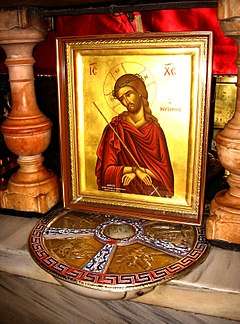
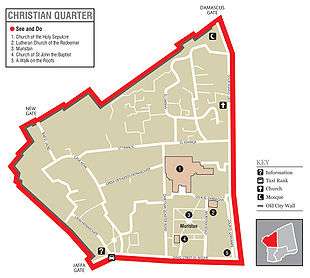
The traditional location of Golgotha derives from its identification by Queen Mother Helena, mother of Constantine the Great, in 325. Only a few steps away (within 45 metres (50 yd)), Helena also identified the location of the tomb of Jesus and claimed to have discovered the True Cross; her son, Constantine, then built the Church of the Holy Sepulchre around the whole site. In 333, the author of the Itinerarium Burdigalense, entering from the east, described the result:
On the left hand is the little hill of Golgotha where the Lord was crucified. About a stone's throw from thence is a vault [crypta] wherein his body was laid, and rose again on the third day. There, at present, by the command of the Emperor Constantine, has been built a basilica; that is to say, a church of wondrous beauty.[20]
In Nazénie Garibian de Vartavan's doctoral thesis, now published as La Jérusalem Nouvelle et les premiers sanctuaires chrétiens de l’Arménie. Méthode pour l’étude de l’église comme temple de Dieu, she concluded, through multiple arguments (mainly theological and archaeological), that the true site of Golgotha was precisely at the vertical of the now buried Constantinian basilica's altar and away from where the traditional rock of Golgotha is situated.[21] The plans published in the book indicate the location of the Golgotha within a precision of less than two meters, below the circular passage situated a metre away from where the blood stained shirt of Christ was traditionally recovered and immediately before the stairs leading down to St. Helena's Chapel (the above-mentioned mother of Emperor Constantine), alternatively called St. Vartan's Chapel.
Temple to Aphrodite
Prior to Helena's identification, the site had been a temple to Aphrodite. Constantine's construction took over most of the site of the earlier temple enclosure, and the Rotunda and cloister (which was replaced after the 12th century by the present Catholicon and Calvary chapel) roughly overlap with the temple building itself; the basilica church Constantine built over the remainder of the enclosure was destroyed at the turn of the 11th century, and has not been replaced. Christian tradition claims that the location had originally been a Christian place of veneration, but that Hadrian had deliberately buried these Christian sites and built his own temple on top, on account of his alleged hatred for Christianity.[22]
There is certainly evidence that circa 160, at least as early as 30 years after Hadrian's temple had been built, Christians associated it with the site of Golgotha; Melito of Sardis, an influential mid-2nd century bishop in the region, described the location as "in the middle of the street, in the middle of the city",[23] which matches the position of Hadrian's temple within the mid-2nd century city.
Romans typically built a city according to a Hippodamian grid plan – a North-South arterial road, the Cardo (which is now the Suq Khan-ez-Zeit), and an East-West arterial road, the Decumanus Maximus (which is now the Via Dolorosa).[24] The forum would traditionally be located on the intersection of the two roads, with the main temples adjacent.[24] However, due to the obstruction posed by the Temple Mount, as well as the Tenth Legion encampment on the Western Hill, Hadrian's city had two Cardo, two Decamanus Maximus, two forums,[24] and several temples. The Western Forum (now Muristan) is located on the crossroads of the West Cardo and what is now El-Bazar/David Street, with the Temple of Aphrodite adjacent, on the intersection of the Western Cardo and the Via Dolorossa. The Northern Forum is located north of the Temple Mount, on the junction of the Via Dolorossa and the Eastern Cardo, adjacent to the Temple of Jupiter Capitolinus intentionally built atop the Temple Mount.[25] Another popular holy site that Hadrian converted to a pagan temple was the Pool of Bethesda, possibly referenced to in the fifth chapter of the Gospel of John,[26][27] on which was built the Temple of Asclepius and Serapis. While the positioning of the Temple of Aphrodite may be, in light of the common Colonia layout, entirely unintentional, Hadrian is known to have concurrently built pagan temples on top of other holy sites in Jerusalem as part of an overall Romanization policy.[28][29][30][31][32]
Archaeological excavations under the Church of the Holy Sepulchre have revealed Christian pilgrims' graffiti, dating from the period that the Temple of Aphrodite was still present, of a ship, a common early Christian symbol[33][34][35] and the etching "DOMINVS IVIMVS", meaning "Lord, we went",[36][37] lending possible support to the statement by Melito of Sardis asserting that early Christians identified Golgotha as being in the middle of Hadrian's city rather than outside.
Rockface
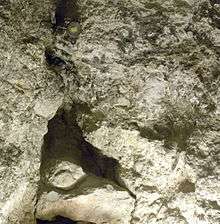
During 1973–1978 restoration works and excavations inside the Church of the Holy Sepulchre and under the nearby Muristan, it was found that the area was originally a quarry, from which white Meleke limestone was struck;[38] surviving parts of the quarry to the north-east of the chapel of St. Helena are now accessible from within the chapel (by permission). Inside the church is a rock, about 7 m long by 3 m wide by 4.8 m high,[38] that is traditionally believed to be all that now remains visible of Golgotha; the design of the church means that the Calvary Chapel contains the upper foot or so of the rock, while the remainder is in the chapel beneath it (known as the tomb of Adam). Virgilio Corbo, a Franciscan priest and archaeologist, present at the excavations, suggested that from the city the little hill (which still exists) could have looked like a skull.[39]
During a 1986 repair to the floor of the Calvary Chapel by the art historian George Lavas and architect Theo Mitropoulos, a round slot of 11.5 cm (4.5 in) diameter was discovered in the rock, partly open on one side (Lavas attributes the open side to accidental damage during his repairs);[40] although the dating of the slot is uncertain, and could date to Hadrian's temple of Aphrodite, Lavas suggested that it could have been the site of the crucifixion, as it would be strong enough to hold in place a wooden trunk of up to 2.5 metres (8 ft 2 in) in height (among other things).[41][42] The same restoration work also revealed a crack running across the surface of the rock, which continues down to the Chapel of Adam;[40] the crack is thought by archaeologists to have been a result of the quarry workmen encountering a flaw in the rock.[43]
Based on the late 20th century excavations of the site, there have been a number of attempted reconstructions of the profile of the cliff face. These often attempt to show the site as it would have appeared to Constantine. However, as the ground level in Roman times was about 4–5 feet (1.2–1.5 m) lower and the site housed Hadrian's temple to Aphrodite, much of the surrounding rocky slope must have been removed long before Constantine built the church on the site. The height of the Golgotha rock itself would have caused it to jut through the platform level of the Aphrodite temple, where it would be clearly visible. The reason for Hadrian not cutting the rock down is uncertain, but Virgilio Corbo suggested that a statue, probably of Aphrodite, was placed on it,[44] a suggestion also made by Jerome. Some archaeologists have suggested that prior to Hadrian's use, the rock outcrop had been a nefesh – a Jewish funeral monument, equivalent to the stele.[45]
Pilgrimages to Constantine's Church
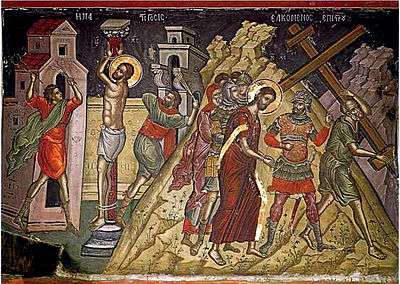
The Itinerarium Burdigalense speaks of Golgotha in 333: "... On the left hand is the little hill of Golgotha where the Lord was crucified. About a stone's throw from thence is a vault (crypta) wherein His body was laid, and rose again on the third day. There, at present, by the command of the Emperor Constantine, has been built a basilica, that is to say, a church of wondrous beauty,"[46] Cyril of Jerusalem, a distinguished theologian of the early Church, and eyewitness to the early days of Constantine's edifice, speaks of Golgotha in eight separate passages, sometimes as near to the church where he and his listeners assembled:[47] "Golgotha, the holy hill standing above us here, bears witness to our sight: the Holy Sepulchre bears witness, and the stone which lies there to this day."[48] And just in such a way the pilgrim Egeria often reported in 383: "… the church, built by Constantine, which is situated in Golgotha …"[49] and also bishop Eucherius of Lyon wrote to the island presbyter Faustus in 440: "Golgotha is in the middle between the Anastasis and the Martyrium, the place of the Lord's passion, in which still appears that rock which once endured the very cross on which the Lord was.",[50] and Breviarius de Hierosolyma reports in 530: "From there (the middle of the basilica), you enter into Golgotha, where there is a large court. Here the Lord was crucified. All around that hill, there are silver screens."[51] (See also: Eusebius in 338.[52])
Gordon's Calvary
In 1842, heavily relying on the research of Edward Robinson, a German theologian and biblical scholar from Dresden named Otto Thenius was the first to publish a proposal that the rocky knoll north of Damascus Gate was the biblical Golgotha.[53][54] In 1882–83, Major-General Charles George Gordon endorsed this view, and subsequently the site has sometimes been known as Gordon's Calvary. The location, usually referred to today as Skull Hill, is beneath a cliff that contains two large sunken holes, which Gordon regarded as resembling the eyes of a skull. He and a few others before him believed that the skull-like appearance would have caused the location to be known as Golgotha.[55]
Nearby is an ancient rock-cut tomb known today as the Garden Tomb, which Gordon proposed as the tomb of Jesus. The Garden Tomb contains several ancient burial places, although the archaeologist Gabriel Barkay has proposed that the tomb dates to the 7th century BC and that the site may have been abandoned by the 1st century.[56]
Eusebius comments that Golgotha was in his day (the 4th century) pointed out north of Mount Zion.[57] While "Mount Zion" was used previously in reference to the Temple Mount itself, Josephus, the first-century AD historian who knew the city as it was before the Roman destruction of Jerusalem, identified Mount Zion as being the Western Hill (the current Mount Zion),[58][59] which is south of both the Garden Tomb and the Holy Sepulchre. Eusebius' comment therefore offers no additional argument for either location.
On Aelia Capitolina's Decumanus
See Joan Taylor's theory in the article's introduction and under Alternative theories.
Outside Lions Gate

Another possible location has been proposed by Rodger Dusatko, a missionary in Germany. He claims that the hill just outside the Lions Gate[60]
All four Gospels use the Greek word kranion to describe the place where Jesus was crucified. Unlike skufion ("skull"), kranion (in English – cranium)[61] is the upper part of the skull excluding the face bones.
Since the temple faced east,[62] the curtain in front of the entrance[63] of the temple would have been in direct view of those gathered on this mount at the northeast corner of the Temple Mount, just outside the city wall. And to testify that the curtain ripped at the very moment when Jesus died,[64] there must have been eyewitnesses.
The Gospel of John refers to Golgotha as being very near the city, so near that all who passed by could read the inscription[19:20]. Considering also the prophecy in Psalms 69:12[69:12], his place of crucifixion would have been near enough to the gate that Jesus could hear what the people were saying about him there. And just as Eusebius comments in Onomasticon concerning Golgotha as being a hill just outside Jerusalem, north of the ancient Mount Zion[57], this hill fits his description.
See also
References
- Schultens, Albert (1737). Institutiones ad fundamenta linguæ Hebrææ: quibus via panditur ad ejusdem analogiam restituendam, et vindicandam : in usum collegii domestici. Johannes Luzac. p. 334.
- Thrupp, Joseph Francis (1855). Antient Jerusalem: A New Investigation Into the History, Topography and Plan of the City, Environs, and Temple, Designed Principally to Illustrate the Records and Prophecies of Scripture. Macmillan & Company. p. 272.
- Lande, George M. (2001) [1961]. Building Your Biblical Hebrew Vocabulary Learning Words by Frequency and Cognate. Resources for Biblical Study 41. Atlanta: Society of Biblical Literature. p. 115. ISBN 1-58983-003-2.
- "H1538 - gulgoleth - Strong's Hebrew Lexicon (KJV)". Blue Letter Bible.
- Chisholm, Hugh, ed. (1911). . Encyclopædia Britannica (11th ed.). Cambridge University Press.
- Matthew 27:33; Mark 15:22 Luke 23:33 John 19:17
- Taylor, Joan (Spring 2002). "Golgotha: A Reconsideration of the Evidence". Bible and Spade. Associates for Biblical Research. Archived from the original on 27 July 2018. Retrieved 27 July 2018.
- so John Lightfoot (ed. Dove 1822) iii.164. Lightfoot points out that golgotha is the Samaritan form of Biblical Hebrew גֻּלְגֹּלֶת in Numeri 1:18 (לְגֻלְגְּלֹתָֽם "by their polls"). see also Samuel James Andrews, The Life of Our Lord Upon the Earth Considered in Its Historical, Chronological, and Geographical Relations (1873), p. 559
- Da Halgan Godspel on Englisc ed. Thorpe (1842), p. 176.
- Luther in this diverges from the pre-Lutheran Lübeck translation, which like Wycliffe retains Latin calvarie. Biblia, Lübeck, 1494 (Bayerischen Staatsbibliothek Rar. 880, p. 430).
- Golgotha is described as "A spot there is called Golgotha, – of old the fathers' earlier tongue thus called its name, 'The skull-pan of a head'." by Five Books in Reply to Marcion, Book 2, Ante-Nicene Fathers Volume 4, p. 276
- Mount Calvary. Catholic Encyclopedia. Vol. III. New York: Robert Appleton Company. 1908.
- Wilhelm Ludwig Krafft, Die Topographie Jerusalems, Bonn (1846)
- Strong's Concordance H1601 "Goah, a place near Jerusalem: Goath."
- James Fergusson, An Essay on the Ancient Topography of Jerusalem (1847), 80f. Ferguson in this disagrees with Krafft, who identified the Goath of Jeremiah with the Gennath Γεννάθ of Josephus, i.e. the "garden gate" to the west of the Temple mount.
- John 19:20
- Chadwick, H. (2003). The Church in Ancient Society: From Galilee to Gregory the Great. Oxford: Oxford University Press. p. 21. ISBN 0-19-926577-1.
- Dan Bahat in German television ZDF, April 11, 2007
- Colonel Claude R. Conder, The City of Jerusalem (1909), (republished 2004); for details about Conder himself, see Herbert Kitchener, 1st Earl Kitchener#Survey of Western Palestine
- Itinerarium Burdigalense, pp. 593, 594
- Garibian de Vartavan, N. (2008). La Jérusalem Nouvelle et les premiers sanctuaires chrétiens de l’Arménie. Méthode pour l’étude de l’église comme temple de Dieu. London: Isis Pharia. ISBN 0-9527827-7-4.
- Eusebius, Life of Constantine, 3:26
- Melito of Sardis, On Easter
- Ball, Warwick. Rome in the East: The Transformation of an Empire. p. 294.
- Clermont-Ganneau, Charles. Archaeological researches in Palestine during the years 1873–1874.
- John 5:1–18
- Jerome Murphy-O'Connor, The Holy Land, (2008), p. 29
- Peter Schäfer (2003). The Bar Kokhba war reconsidered: new perspectives on the second Jewish revolt against Rome. Mohr Siebeck. pp. 36–. ISBN 978-3-16-148076-8. Retrieved 4 December 2011.
- Lehmann, Clayton Miles (22 February 2007). "Palestine: History". The On-line Encyclopedia of the Roman Provinces. The University of South Dakota. Archived from the original on 10 March 2008. Retrieved 18 April 2007.
- Cohen, Shaye J. D. (1996). "Judaism to Mishnah: 135–220 C.E". In Hershel Shanks (ed.). Christianity and Rabbinic Judaism: A Parallel History of their Origins and Early Development. Washington DC: Biblical Archaeology Society. p. 196.
- Emily Jane Hunt, Christianity in the second century: the case of Tatian, p. 7, at Google Books, Psychology Press, 2003, p. 7
- E. Mary Smallwood The Jews under Roman rule: from Pompey to Diocletian : a study in political relations, p. 460, at Google Books Brill, 1981, p. 460.
- Nave New Advent encyclopedia, accessed 25 March 2014.
- Ship as a Symbol of the Church (Bark of St. Peter) Jesus Walk, accessed 11 February 2015.
- "Ship hangs in balance at Pella Evangelical Lutheran Church". Sidney (Montana) Herald. 10 June 2008. Retrieved 3 January 2016.
- Clermont-Ganneau, Charles. Archaeological researches in Palestine during the years 1873–1874. p. 103.
- followinghadrian (5 November 2014). "Exploring Aelia Capitolina, Hadrian's Jerusalem". Archived from the original on 18 February 2017. Retrieved 28 February 2017.
- Hesemann, Michael (1999). Die Jesus-Tafel (in German). Freiburg. p. 170. ISBN 3-451-27092-7.
- Hesemann 1999, p. 170: "Von der Stadt aus muß er tatsächlich wie eine Schädelkuppe ausgesehen haben," and p. 190: a sketch; and p. 172: a sketch of the geological findings by C. Katsimbinis, 1976: "der Felsblock ist zu 1/8 unterhalb des Kirchenbodens, verbreitert sich dort auf etwa 6,40 Meter und verläuft weiter in die Tiefe"; and p. 192, a sketch by Corbo, 1980: Golgotha is distant 10 meters outside from the southwest corner of the Martyrion-basilica
- George Lavas, The Rock of Calvary, published (1996) in The Real and Ideal Jerusalem in Jewish, Christian and Islamic Art (proceedings of the 5th International Seminar in Jewish Art), pp. 147–150
- Hesemann 1999, pp. 171–172: "....Georg Lavas and ... Theo Mitropoulos, ... cleaned off a thick layer of rubble and building material from one to 45 cm thick that covered the actual limestone. The experts still argue whether this was the work of the architects of Hadrian, who aimed thereby to adapt the rock better to the temple plan, or whether it comes from 7th century cleaning....When the restorers progressed to the lime layer and the actual rock....they found they had removed a circular slot of 11.5 cm diameter".
- Vatican-magazin.com, Vatican 3/2007, pp. 12/13; Vatican 3/2007, p. 11, here p. 3 photo No. 4, quite right, photo by Paul Badde: der steinere Ring auf dem Golgothafelsen.
- "502 Bad Gateway nginx openresty 208.80.154.49". www.holyplacesinisrael.com. Archived from the original on March 18, 2009.
- Virgilio Corbo, The Holy Sepulchre of Jerusalem (1981)
- Dan Bahat, Does the Holy Sepulchre Church Mark the Burial of Jesus?, in Biblical Archaeology Review May/June 1986
- abela, john. "Bordeaux Pilgrim – Text 7b: Jerusalem (second part)". Archived from the original on 2016-05-13. Retrieved 2011-10-25.
- "St. Cyril of Jerusalem" (PDF). p. 51, note 313. Archived from the original (PDF) on 2007-06-16. Retrieved 2007-06-12.
- "Cyril, Catechetical Lectures, year 347, lecture X" (PDF). p. 160, note 1221. Archived from the original (PDF) on 2007-06-16. Retrieved 2007-06-12.
- Iteneraria Egeriae
- Letter To The Presbyter Faustus Archived 2008-06-13 at the Wayback Machine, by Eucherius. "What is reported, about the site of the city Jerusalem and also of Judaea"; Epistola Ad Faustum Presbyterum. "Eucherii, Quae fertur, de situ Hierusolimitanae urbis atque ipsius Iudaeae." Corpus Scriptorum Eccles. Latinorum XXXIX Itinera Hierosolymitana, Saeculi IIII–VIII, P. Geyer, 1898
- Whalen, Brett Edward, Pilgrimage in the Middle Ages, p. 40, University of Toronto Press, 2011, ISBN 978-1-4426-0199-4; Iteneraria et alia geographica, Corpus Christianorum Series Latina, vol. 175 (Turnhout, Brepols 1965), pp. 109–112
- "NPNF2-01. Eusebius Pamphilius: Church History, Life of Constantine, Oration in Praise of Constantine – Christian Classics Ethereal Library".
- Charles W. Wilson, Golgotha and The Holy Sepulchre (1906, The Committee of the Palestine Exploration Fund), pp. 103-120
- Otto Thenius, "Golgatha et Sanctum Sepulchrum" in Zeitschrift fir die historische Theologie (1842)
- Bill White, A Special Place: The Story of the Garden Tomb (1989).
- Gabriel Barkay, The Garden Tomb, published in Biblical Archaeology Review March/April 1986
- Eusebius, Onomasticon, 365
- "Zion, Encyclopædia Britannica".
- The Unknown Mount Zion
- "Golgotha Rediscovered".
- cranium – The bony case enclosing the brain, excluding the bones of the face; braincase – American Heritage Medical Dictionary
- "East orientation of Jewish temples and altars".
- "Peshitta Mat 27".
- But Yeshua cried again with a loud voice, and his Spirit departed. And at once the curtain entrance of The Temple was ripped in two from top to bottom. Mt 27,50-51 Peshitta
External links

- Golgotha Rediscovered – proposes that Golgotha was outside Lions' Gate
- Polish Calvaries: Architecture as a Stage for the Passion of Christ